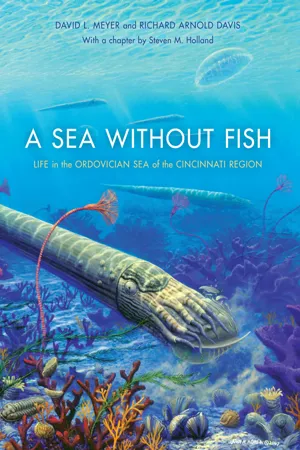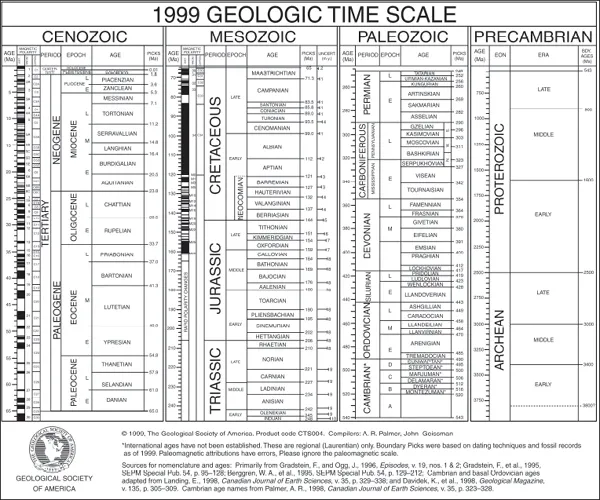![]()
Figure 1.1. 1999 Geologic Time Scale. Reprinted by permission of the Geological Society of America. In order to read this chart in stratigraphic order, read the columns from bottom to top, starting at the bottom of the Precambrian column, adding the bottom of the Paleozoic column to the top of the Precambrian column, the bottom of the Mesozoic column to the top of the Paleozoic column, and the bottom of the Cenozoic column to the top of the Mesozoic column.
1
INTRODUCTION
The vicinity of Cincinnati, in the Ohio River Valley of southwestern Ohio, including adjacent northern Kentucky and southeastern Indiana, is among the most fossil-rich regions in North America, if not the entire world. The profusion of fossils in the local limestone and shale attracted many pioneering geologists and paleontologists of the nineteenth century, and much fundamental work in American paleontology and stratigraphy was accomplished here. Hundreds of fossil species were first discovered and named from these rocks. Early geologists gave the entire series of strata exposed here the name “Cincinnatian,” and this name was applied to strata of similar age throughout North America. Cincinnatian fossils are displayed in museums all over the world. Researchers, students, and amateur fossil collectors regularly visit the Cincinnati region to collect fossils. Many of those who have grown up in the region are aware of the abundance of fossils, yet few appreciate the uniqueness of this richness and its broader significance to our understanding of the Earth’s past. The purpose of this book is to explore the richness of Cincinnatian fossils and the stories they tell about life over 450 million years ago, when shallow seas inundated North America and the site of Cincinnati was in the Southern Hemisphere.
Why are fossils so abundant in the rocks of Cincinnati’s hills? Beyond sheer abundance, what is their significance for our knowledge of the history of life, evolution, and ancient environments? There is no single answer to these questions, but rather several answers can be given which collectively reveal the significance of Cincinnatian fossils. These answers can be found under four categories: organic evolution, environment, preservation, and history.
Of the many prolific collecting grounds in the continental interior, none excels the Ohio river bluffs at Cincinnati, Ohio. Here the Upper Ordovician rocks are almost literally made of fossils; many are as perfectly preserved as fossils can be. The river banks, road cuts, and even the soil in the gardens are replete with fossils more common than pebbles. Almost every museum in the world has specimens from this locality.
William Lee Stokes 1960, 188–189
Organic Evolution
[The Ordovician radiation] represents one of the largest major turnovers in the history of life and marks the appearance of groups that came to dominate marine ecosystems for the next 250 million years.
Droser, Fortey, and Li 1996, 122
Fossils found in Cincinnati’s limestones and shales are the remains of animals that lived during an interval of Earth history called the Ordovician Period. The Ordovician is the second oldest period of the larger time interval known as the Paleozoic Era (Figure 1.1). The beginning of the Paleozoic Era (meaning “time of ancient animals”) is marked by the oldest rocks containing abundant fossils of multi-celled animals (metazoans). Radiometric dating of volcanic ash beds interbedded with these fossiliferous rocks places the beginning of the Paleozoic at about 543 million years ago. Similar methods date the beginning of the Ordovician Period at about 490 million years ago and its end at about 443 million years ago. The span of Ordovician time represented by the Cincinnatian strata amounted to less than 10 million years, and fell approximately during the latter part of the Ordovician, termed the Late Ordovician. In the Cincinnati region, a total thickness of over 250 meters (820 feet) of interbedded limestone and shale was deposited during the Late Ordovician, constituting the Cincinnatian and containing fossils throughout. Further discussion of the nature and subdivisions of Cincinnatian rocks, and estimates of their age, are the subject of chapter 4.
Figure 1.2. Diversity of marine fossil metazoan families through the Phanerozoic. The heavy uppermost curve depicts the sum of the three “evolutionary faunas,” each shaded differently, while the stippled portion below the total curve represents residual diversity not accounted for by the three component faunas. Taxa listed for each evolutionary fauna are those taxa that contribute most heavily to the diversity of that fauna. I = Cambrian Fauna, II = Paleozoic Fauna, and III = Modern Fauna. From Sepkoski (1981) and reprinted by permission of The Paleontological Society.
Professor Stig M. Bergström of the Ohio State University is among the world’s most knowledgeable and widely-traveled specialists on Ordovician fossils and stratigraphy. He indicated to us that “there is nothing that can be compared elsewhere in the world” to the diversity of shelly fossils in the Cincinnatian (Bergström, pers. comm.). Metazoan marine life first began to diversify during the so-called Cambrian explosion that marked the onset of the Paleozoic, but accelerated during the Cambrian and Ordovician Periods to reach a peak late in the Ordovician when the Cincinnatian strata were deposited. In fact the Ordovician Period is recognized as a unique time of evolutionary diversification, termed the Ordovician Radiation (Droser et al. 1996) or the Ordovician Biodiversification Event (Webby, Paris, Droser, and Percival 2004). The Ordovician marked a convergence of what Sepkoski (1981) called three “evolutionary faunas”: metazoan groups that first appeared during the Cambrian but persisted into the Ordovician (“Cambrian Fauna”), groups that began to diversify during the Ordovician (“Paleozoic Fauna”), and groups that first appeared in the Ordovician that diversified after the end of the Paleozoic (“Modern Fauna”) (Figure 1.2). At the end of the Ordovician there occurred a global mass extinction that eliminated species on a large scale. Thus the Cincinnatian time was significant in the history of life as a Golden Age of evolutionary diversification just before a major crisis of mass extinction. In many ways the Late Ordovician is comparable to the Late Cretaceous Period, another Golden Age preceding a crisis (Figure 1.2; Seilacher 1998). Few if any fossil species found in the Cincinnatian strata survived into the succeeding Silurian Period. Chapters 5–14 introduce each of the major groups of organisms found as fossils in the Cincinnatian.
The environment of Late Ordovician time in the Cincinnati region contributed to the abundance and richness of fossils in several fundamental ways. Cincinnatian fossils and rocks bear profound testimony to the existence of widespread shallow seas (called epicontinental or epeiric seas) over most of the North American continent at this time (Plate 1). Using many sources of evidence, geologists have compiled a record of the rise and fall of sea level during the past half billion years of Earth history (Figure 1.3). The Late Ordovician was one of the times of maximum rise of sea level over the entire globe, rivaled only by the Late Cretaceous (according to the reconstruction by Hallam [1984]). The cause of this flooding has been attributed to high rates of sea floor spreading which swelled the mid-ocean ridges, displacing immense volumes of seawater from the deep ocean basins onto the continental plates. The Atlantic Ocean as we know it did not exist, but instead, a narrower ocean called the Iapetus Ocean separated North America from continental plates later to constitute Europe and Africa (Plate 1). The nearest landmasses to the Cincinnati region were the rising Appalachian mountain chain, about 300 miles to the east, and the low-lying Canadian Shield to the north. Just before and during the Late Ordovician, a phase of major tectonic (mountain-building) activity, the Taconic Orogeny, resulted in severe crustal deformation and uplift along the region bordering New York and New England. Islands were raised high above sea level as lofty and jagged mountain chains resembling the modern Alps or Himalayas. Weathering and erosion attacked these ranges, and rivers carried huge loads of fresh water, sediments, and nutrients into the shallow sea.
Great volumes of sediment, consisting of coarse gravels, sands, silts, and muds (termed siliciclastics) were deposited as river deltas and redistributed by oceanic currents near the coastline in the Appalachian Basin. The total thickness of the Late Ordovician strata in the Appalachian Basin in Virginia reaches about 1000 meters (over 3000 feet) whereas the same time interval is represented in the Cincinnati region by strata less than 300 meters (less than 1000 feet) thick (Figure 1.4; Kay 1951). Offshore, only the muddy components of this heavy sediment input remained suspended as clay particles, and were carried by currents to reach the Cincinnati area. These muds were thus imports to the region that eventually lithified (turned to stone) to form shales. In the Cincinnati area, shales are interbedded with limestones, which are composed of calcareous shells and skeletons of “native” marine invertebrates. In the western United States and Canada, the Late Ordovician contains mostly limestones secondarily converted to dolomites. Thus, the Cincinnati region represents an intermediate zone of mixed shales and limestones between the great thickness of siliciclastics to the east and pure limestones farther west. Both sediments intermingled in the Cincinnati region, producing a varied and patchy sea floor that was muddy in places and shelly in others. Such a variegated bottom environment offered more potential types of living spaces for bottom-dwelling organisms (the benthos), and provides a further reason why high diversity developed in the region. Because there was very little vegetation on land during the Late Ordovician, erosion may have carried a heavier load of dissolved inorganic nutrients into the sea. These nutrients may have acted as a fertilizer to stimulate the production of benthic biomass. In addition, climate, oceanographic conditions, and available food supply must have been crucial to support prolific marine life in the Cincinnatian sea; these factors are explored in detail in chapter 15.
We are accustomed to thinking of North America as terra firma, one of the large high and dry segments of the earth’s crust, and it is difficult for us to imagine a time in the past when our continent was so submerged beneath the sea that fish could have swum directly from the Atlantic Ocean to the Pacific Ocean, from Hudson Bay to the Gulf of Mexico. Yet such a time did exist 450 million years ago when the epeiric sea spread from Arctic to Gulf, from Atlantic to Pacific.*
Clark and Stearn 1960, 68
*Of course, true bony fish had not yet evolved in Late Ordovician time, and as we will see, Cincinnatian rocks contain no fossil evidence of the early, jawless fish that are known from the Late Ordovician elsewhere.
Figure 1.3. Global sea level curves for the Phanerozoic. A. Hallam curve, B. Vail et al. curve (1977). From Hallam (1984) and reprinted by permission of Annual Reviews. According to more recent studies (Miller et al. 2006), maximum rise of sea level in the Cretaceous was lower than these estimates, reaching 100 m ± 50 m above present sea level, but this does not contradict the evidence that Ordovician sea level was also very high and extensive over North America.
When we look at rock layers as crowded with well-preserved fossils as those of the Cincinnatian, we tend to think we are looking at a complete picture of life on the Ordovician sea floor—a snapshot—in terms of both the diversity of species present and their abundance. Unfortunately, the correspondence between this fossil assemblage and the original living community from which it was derived is rarely that simple and direct. The fossil record provides a mere glimpse of ancient life, one that is heavily biased by many factors. In order to assess the impact of these factors on the quality of the fossil sample, paleontologists have devoted an entire subdiscipline, called taphonomy, to the investigation of processes affecting organic remains from death to ultimate fossilization. Taphonomy emphasizes the wide variation in the preservation potential of organisms. An appreciatio...



